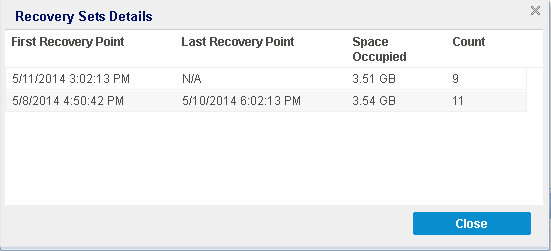

The Status Summary section of the home page provides a quick and easy, high-level status of your backup health.

Displays the date and time of the last backup, with the status of that backup.
Displays the number of Recovery Points or Recovery Sets for your monitored server based on your specified retention settings.
If you specified your retention settings based on recovery sets, the status summary displays the number of recovery sets already retained and the number of recovery sets in progress. In addition, click the link under Recovery Sets to display the Recovery Sets Details dialog. This dialog contains detailed information about the contents of the recovery set.
Note: The Recovery Sets option is available if you select Standard as your Backup Data Format. However,the Recovery Sets option is not available if you select Advanced as your Backup Data Format. For more information about recovery sets, see Specify Retention Settings in the online help.

The date/time of the first backup in the recovery set.
The date/time of the last backup in the recovery set. With the first/last recovery point time listed, you are able to determine the complete time range of the recovery set.
The total size of the recovery set. This number can be used to calculate how much disk space is used by the recovery set.
The number of recovery points that belong to the recovery set.
Displays the amount of free space available at your backup destination. The Destination Capacity display provides an additional indication of the amount of space that is used for the backups, the amount of space that others use, and the amount of available free space.
Immediately increase the free space capacity of the backup destination or change the destination to another location which has adequate space.
Note: You can set up an email alert notification when the amount of unused space at the backup destination is less than a specified value. For more information about setting up this email alert notification, see Specify Email Alert Preferences in the online help.
If a backup fails because of a license validation failure, the License Failure status is displayed indicating which license was the cause of the failure.
Displays the status of Arcserve UDP Agent (Windows) updates for your computer.
You can then click Click here to install updates to trigger the installation of the update.
For more information about configuring the Update Schedule, see Specify Updates Preferences in the online help.
Note: All updates that are released for Arcserve UDP Agent (Windows) are cumulative. As a result, each update also includes all previously released updates to help ensure that your computer is always up-to-date.
Displays the date and time of the last File Copy job, with the status of the File Copy job that was performed.
In addition, the Last File Copy status indicator also displays the actual amount of space that is freed on the disk by the File Copy job. This space saved calculation is only displayed if you select to move the File Copy to a different location instead of copying the File Copy to as different location. This value is based upon the actual size of the backup that was moved from the computer to the specified destination. A File Copy job that does not move the copy to a different location, does not save any space.
Note: For Windows Server 2012 NTFS, the Backup size displayed is the data deduplication un-optimized size. If the Arcserve UDP Agent (Windows) backup destination is configured with Windows NTFS data deduplication enabled, the Backup size may be larger than the actual data size on the disk.
Note: If the backup destination is set to data store, this status bar does not display.
|
Copyright © 2016 |
|